|
|
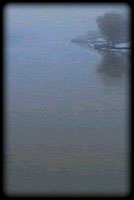 Summing up the results of biological surveys of inspectoraters for enviromnemt protection, we can tell the followings about the effect of contamination. As a result of microscopic investigations it can be stated, that cyanide contamination on the affected sections of Szamos and Tisza resulted in the destruction of the major part of planctonic organisms. In the period of going down of contamination wave the measure of destruction was 100 % on Szamos. It varied between 70 and 90 % on the upper and middle course of Tisza, while on the lower course it was again around 100 %. Increase of the exposition time (which could have been considered about 6 hours on Szamos and 50-60 hours on the Lower Tisza) could have played a significant role in it. According to the results of biological surveys made on the Hungarian part of Szamos on 25. February 2000 some two weeks after going down of contamination, beside living phytoplanctonic organisms (algae) the skeleton of many dead beings could be revealed. The situation was similar on the Upper Tisza too. In this period planctonic organisms were characterized by low number but a composition of species adequate for the season. The results of zooplanctonic surveys made in the sections of Middle and Lower Tisza showed, that in the period of contamination species of wheel animalcules (Rotatoria) and water fleas (Cladocera) were
destroying alike. Summing up the results of biological surveys of inspectoraters for enviromnemt protection, we can tell the followings about the effect of contamination. As a result of microscopic investigations it can be stated, that cyanide contamination on the affected sections of Szamos and Tisza resulted in the destruction of the major part of planctonic organisms. In the period of going down of contamination wave the measure of destruction was 100 % on Szamos. It varied between 70 and 90 % on the upper and middle course of Tisza, while on the lower course it was again around 100 %. Increase of the exposition time (which could have been considered about 6 hours on Szamos and 50-60 hours on the Lower Tisza) could have played a significant role in it. According to the results of biological surveys made on the Hungarian part of Szamos on 25. February 2000 some two weeks after going down of contamination, beside living phytoplanctonic organisms (algae) the skeleton of many dead beings could be revealed. The situation was similar on the Upper Tisza too. In this period planctonic organisms were characterized by low number but a composition of species adequate for the season. The results of zooplanctonic surveys made in the sections of Middle and Lower Tisza showed, that in the period of contamination species of wheel animalcules (Rotatoria) and water fleas (Cladocera) were
destroying alike. 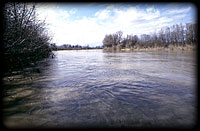 After the contemination went down both density of individuals and number of species increased, but because the flood wave appearing in mid February it was of a small degree. After the contamination went down early spring conditions were typical. In the beginning of resettlement species of better adaptation ability played a major role, mainly wheel animalcules. In that time the composition of the plancton is less diverse. Greater richness in species formed only few weeks later. During the heavy metal contamination in March a decreasing tendency precailed again, but this cannot be brought into connection with the contamination unambiguously, in decrease of number of species and individuals primary role have been played by flood. Forming of plancton stock of Tisza have significantly been influenced by inflowing tributaries and stocks of the Tisza Lake. That is why in different sections a zooplancton different in density and in composition of species could be observed, and in addition, species not typical to the Tisza appeared as well.
After the contemination went down both density of individuals and number of species increased, but because the flood wave appearing in mid February it was of a small degree. After the contamination went down early spring conditions were typical. In the beginning of resettlement species of better adaptation ability played a major role, mainly wheel animalcules. In that time the composition of the plancton is less diverse. Greater richness in species formed only few weeks later. During the heavy metal contamination in March a decreasing tendency precailed again, but this cannot be brought into connection with the contamination unambiguously, in decrease of number of species and individuals primary role have been played by flood. Forming of plancton stock of Tisza have significantly been influenced by inflowing tributaries and stocks of the Tisza Lake. That is why in different sections a zooplancton different in density and in composition of species could be observed, and in addition, species not typical to the Tisza appeared as well.
|
Results of investigations on macroscopic aquatic invertebratesThe effect of cyanide contamination on invertebrate fauna of the sediment has been investigated on the lower course of the Tisza during and after the contamination too. As a result of these investigations it could be stated, that on this course during the contamination period species of annelids (Oligochaeta) did not suffer damage. In contrast, larvae of midges (Chironomidae) were destroyed in a significant part. It has been observed too, that destruction kept on after the contamination went down. This has been confirmed both by laboratory and field investigations.
|
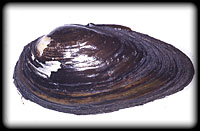
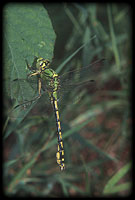 It could be stated by the results of the survey in March, that with the exception of crustaceans all groups of beings occurred in large number of speecies in the Szamosban and the Tisza. Data of mussels proved, that, they are present both above and below
the mouth of Szamos, cyanide contamination did not destroy their stocks. Water snails are typical of the water space of the Kisköre reservoir, gravel snail (Lithoglyphus naticoides) was present in a very large number of individuals. Beside the
numerous crustacean species, which could be shown, it was conspicuous, that certain colonies of a water-flea species (Corophium curvispinum) could not be found in places already known before. Among ephemerids (Ephemeroptera) the larvae of
only few species could be collected in the spring season. Many groups were present only in egg state. Among dragonflies (Odonata) all species could be found among
those found before in March within the water spaces, and we hope this tendency will prevail in latter parts of the year too. In contrast, false ephemerids (Plecoptera) however, species occurring before have flown out earlier, but their larvae could be shown in all sections known before.
It could be stated by the results of the survey in March, that with the exception of crustaceans all groups of beings occurred in large number of speecies in the Szamosban and the Tisza. Data of mussels proved, that, they are present both above and below
the mouth of Szamos, cyanide contamination did not destroy their stocks. Water snails are typical of the water space of the Kisköre reservoir, gravel snail (Lithoglyphus naticoides) was present in a very large number of individuals. Beside the
numerous crustacean species, which could be shown, it was conspicuous, that certain colonies of a water-flea species (Corophium curvispinum) could not be found in places already known before. Among ephemerids (Ephemeroptera) the larvae of
only few species could be collected in the spring season. Many groups were present only in egg state. Among dragonflies (Odonata) all species could be found among
those found before in March within the water spaces, and we hope this tendency will prevail in latter parts of the year too. In contrast, false ephemerids (Plecoptera) however, species occurring before have flown out earlier, but their larvae could be shown in all sections known before.
|
Degree of fish mortality and data concerning the composition of species in question
|
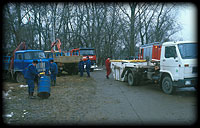
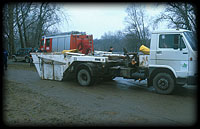 Fish carcases transported to protein processing
works within the longitudinal section of the river exceeded 150 tons. This is however, is only a fraction of the amount effectively died, because individuals of smaller
species have not been collected at all, and investigations have proved, that very large amount of dead fish remained in the sediment, only one part of which has turned
up to the surface, and only much later.
Fish carcases transported to protein processing
works within the longitudinal section of the river exceeded 150 tons. This is however, is only a fraction of the amount effectively died, because individuals of smaller
species have not been collected at all, and investigations have proved, that very large amount of dead fish remained in the sediment, only one part of which has turned
up to the surface, and only much later.
|
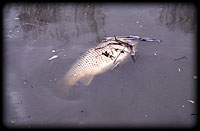
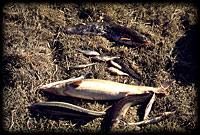 Because of these effective damage can be estimeted only indirectly. Comparing the results of surveys of the former years and estimations of fish stock after the contamination calculations show, that total death
was 1241 tons, 33.8 % of which is carnivure fish, 13.5 % carp (Cyprinus carpio), 8.1 % sterlet (Acipenser ruthenus) and 44.6 % herbivore and other kinds of fishes. Estimated and calculated value of dead commercial fishes is 874 million Hungarian Forints.
Because of these effective damage can be estimeted only indirectly. Comparing the results of surveys of the former years and estimations of fish stock after the contamination calculations show, that total death
was 1241 tons, 33.8 % of which is carnivure fish, 13.5 % carp (Cyprinus carpio), 8.1 % sterlet (Acipenser ruthenus) and 44.6 % herbivore and other kinds of fishes. Estimated and calculated value of dead commercial fishes is 874 million Hungarian Forints.
|
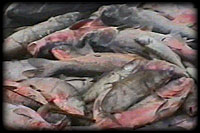 Pathological and histological investigations made during the contamination - beside negative results of parasitic and bacteriological analyses -
proved, that fish mortality was caused by acute cyanide poisoning. Cherry red colour of gills (branchia) of fishes, and that of the blood itself refers to the poisoning, which is caused primarily by saturation with oxygen and forming of bright red
cyanomethemoglobin. Histological investigations also have been made on dead individuals (MSZ 21978/17-85). According to these total cyanide content of muscle and liver tissues of fresh dead fishes varied between 0.22 and 3.3 mg/kg, certain species
showed different values. Muscle of fishes of different species taken out from the Tisza 3 weeks after the contamination went down did not contain traceable amount of cyanide (0.1 mg/l). In connection with contamination of river sections in question with heavy metals beside cyanide, most typical was the increase of copper content. Considering, that the fact of acute poisoning caused by copper in natural waters cannot be proved with full definiteness either by pathological-histological or chemical-analytical investigations, possible role of copper pollution in poisoning can neither be proved nor disproved. In copper, zinc, lead, mercury and cadmium content of organs of fishes collected in the time of crowdy destructuon and three weeks after the contamination went down, such heavy metal enrichment could not be proved, which could be linked to the given environment pollution. Investigations on heavy metal content of different organs of fishes showed, that lead concentration within muscle tissues stayed much below the limit (0.5 mg/kg). Lead concentrations above the limit could be measured in the liver and gills of fishes. Investigation of copper and zinc concentration has brought a similar result; in muscle of fishes it stayed under the limit (10 mg/kg in case of copper and 100 mg/kg in case of zinc), while in certain cases in liver and kidney results above the limit were shown.
Pathological and histological investigations made during the contamination - beside negative results of parasitic and bacteriological analyses -
proved, that fish mortality was caused by acute cyanide poisoning. Cherry red colour of gills (branchia) of fishes, and that of the blood itself refers to the poisoning, which is caused primarily by saturation with oxygen and forming of bright red
cyanomethemoglobin. Histological investigations also have been made on dead individuals (MSZ 21978/17-85). According to these total cyanide content of muscle and liver tissues of fresh dead fishes varied between 0.22 and 3.3 mg/kg, certain species
showed different values. Muscle of fishes of different species taken out from the Tisza 3 weeks after the contamination went down did not contain traceable amount of cyanide (0.1 mg/l). In connection with contamination of river sections in question with heavy metals beside cyanide, most typical was the increase of copper content. Considering, that the fact of acute poisoning caused by copper in natural waters cannot be proved with full definiteness either by pathological-histological or chemical-analytical investigations, possible role of copper pollution in poisoning can neither be proved nor disproved. In copper, zinc, lead, mercury and cadmium content of organs of fishes collected in the time of crowdy destructuon and three weeks after the contamination went down, such heavy metal enrichment could not be proved, which could be linked to the given environment pollution. Investigations on heavy metal content of different organs of fishes showed, that lead concentration within muscle tissues stayed much below the limit (0.5 mg/kg). Lead concentrations above the limit could be measured in the liver and gills of fishes. Investigation of copper and zinc concentration has brought a similar result; in muscle of fishes it stayed under the limit (10 mg/kg in case of copper and 100 mg/kg in case of zinc), while in certain cases in liver and kidney results above the limit were shown.
|
|
|
|
|
|
Evaluation of investigations made on contaminated sections of the Eastern and Western main channel can serve as a base for better understanding the changes ensue on the Tisza. Degree of contamination was lower on the two channels, and partly as a result of their size, partly of ecological research (series of annotations) going on here for years are suitable for completing model studies. Facts experienced here showed, that the composition of fish stock on the affected section transformed in part. Beside perishing the reason of this in major part is drifring away. Among ecologists it is a well known fact, that in newly inhabited habitats in the first time a fauna differing in quantity (larger) and structure takes shape. On habitats of the two channels staying quoth he "empty" due to the contamination the amount of fish food organisms was higher in comparison with the usual, because one part of these (plancton) have been regenerated relatively quickly and the secound part (benthos) has not been damaged significantly. In consequence of this on good fish keeping places even from late spring through the whole year higher numbers of individuals and species could be experienced than usual. Beside this we can explain the multiple amount of fish offsprings in year 2000 with decrease of habitat and food concurrence on the affected course.
|
From the facts outlined above, among conclusions can be drawn concerning the fish stock of the Tisza we emphasize only three essential things. One of them is, that after contaminations "abundance" of fishes suggested by anglers and in not a small degree by the media can be considered as a local phenomenon, thus typical only to certain, well definable points (such as the low water of Kisköre barrage) and refer exactly to the disturbed state. The other fact is, that during inhabiting the water space so-called pioneer species able to spread aggressively are in advantage, 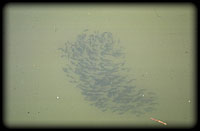 the possible gradation of which (appearing of course not in the year of the contamination, as reports informed us, but three or four years later) is a great risk, what can change natural construction of fish stock for a long period. The third fact is, that settlements made in the spring are mainly unnecessary, appearing even disadvantageous in certain cases, because thanks to permanent high water level an amount of offsprings, incomparable with settled fish amount, have got into the Tisza, and on top of all that such species have been settled in large amounts too, which were less damaged by cyanide contamination. Settling lake-farm carp for instance was definitely harmful from the viewpoint of nature conservation and fishing as well. By the way it is only an illustration, that in a water space with the character and size of the Tisza the stocks of them are artificially sustainable even considering only those fishes which can be settled, i. e. which can be raised in lake-farms. This fact however, shows further, namely in the direction, that the revitalization of the Tisza and sustaining the richness of plant and animal life (biodiversity) on a long period can be solved only by revaluation of water farming of the Tisza valley! the possible gradation of which (appearing of course not in the year of the contamination, as reports informed us, but three or four years later) is a great risk, what can change natural construction of fish stock for a long period. The third fact is, that settlements made in the spring are mainly unnecessary, appearing even disadvantageous in certain cases, because thanks to permanent high water level an amount of offsprings, incomparable with settled fish amount, have got into the Tisza, and on top of all that such species have been settled in large amounts too, which were less damaged by cyanide contamination. Settling lake-farm carp for instance was definitely harmful from the viewpoint of nature conservation and fishing as well. By the way it is only an illustration, that in a water space with the character and size of the Tisza the stocks of them are artificially sustainable even considering only those fishes which can be settled, i. e. which can be raised in lake-farms. This fact however, shows further, namely in the direction, that the revitalization of the Tisza and sustaining the richness of plant and animal life (biodiversity) on a long period can be solved only by revaluation of water farming of the Tisza valley!
|
|
Investigations on surveying damages caused in the environment and nature by the contamination of Szamos and Tisza rivers
The contamination described in chapters above, and the degree of damage in the environment and nature ensued as an effect of that, has made/makes necessary to elaborate and carry out an overall, uniform and long term action program. In the course of it after the contamination wave went down on the affected catchment area of the river course, after-surveys and recordings on the state of the enviromnent and nature should be done at least until the recovering of the original condition. Since only a biomonitoring survey of scientific pretensions can serve as a basis for interventions aiming both revitalization and long term sustain of Szamos and the Tisza. The overall coordination of the survey program has been elaborated by the Institute for Water Quality Protection of VITUKI Co., in full collaboration with institutions taking part in the execution of the program and responsible for certain tasks. In the elaboration of the program the colleagues of the following institutions were taking part: Ministry of Environment Protection Office of Nature Protection Department of Nature Conservation; Institute of Environment Managenment Institute of Environment Protection; Fish Breeding Research Institute; Upper Tisza Region Environment Protection Inspectorate; Environment Protection Inspectorate of Northern Hungary; Environment Protection Inspectorate of areas south of the Tisza; Environment Protection Inspectorate of the Middle Tisza Regoin; Directory Boards of the Hortobágy National Park, the Kiskunság National Park, the Kőrös-Maros National Park and the Bükk National Park. In addition to this in the execution of the work other cooperationg organisms, universities, research institutes and social organizations take part.
|
|
Results of the recommended survey program should give an answer to all questions arising up, the description of acute and permanent (long term acute) effects of pollutants, and circumstances and ways of promotion of rehabilitation of the environment alike. Depending on the character of the contamination the survey program can be divided into three stages. The task of the first stage is to describe changes in concentrations of conservative pollutants of high toxicity, going down the water body. Measurment and estimation of the degree of death and extinction appearing in different communities of organisms as a result of acute toxicity sould be started. The secound stage is to determine permanent damages, and those can be treated only on long distance and caused by pollutants passed away. It is aimed by surveys of damaging effects ensued in macroscopic invertebrate populations in the sediment of the river bed, and investigation of the degree of damage caused in food chain, and organization of communities. Beyond surveying environmental damages all economic and other type of damages should be investigated and analysed, which have been emerged as a result of contamination e. g. in connection with natire conservation, agriculture, turism, services and industrial production. The third stage aims the reduction of observed permanent damages and investigations on the regeneration of living communities, especially aquatic ones, until the conditions preceding contamination restores approximately.
© 1996-2001 TERRA Foundation for Nature Conservation and Education Last update: Webmester, 26. December 2000. |